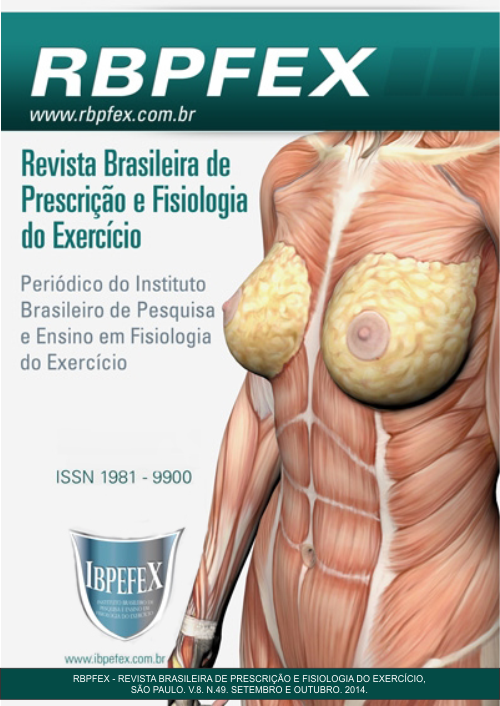Analisi acuta della forza massimale dopo l'allenamento aerobico
Abstract
Obiettivo: Il presente studio è dedicato all'analisi dell'eventuale interferenza dell'allenamento aerobico nella produzione di forza negli esercizi di bench press (SR), 45º leg press (LP) e bicipite curl (BC). Metodologia: il campione era costituito da 8 individui addestrati di entrambi i sessi con un'età media di 27,2 anni ± 5,12 e un'altezza di 169,7 cm ± 10,7. Nella prima fase dell'esperimento sono stati raccolti i dati e verificata la forza massima attraverso il test 1RM; nella seconda fase, è stato eseguito un protocollo di allenamento della forza (ST) al 70% dell'1RM con tre serie fino al cedimento concentrico e un intervallo di tre minuti tra le serie, e nella terza fase, un protocollo di allenamento simultaneo (TC) con 20 minuti di allenamento aerobico al 70-75% FCmax. precedente il TF. Risultati: i risultati del test dimostrano che non vi era alcuna differenza significativa nella media delle ripetizioni nel protocollo TF rispetto alla media delle ripetizioni nel protocollo TC per gli esercizi LP 48,7±10,32; 45,1±15,01 e BC 29,5±3,82; 29.1±4.45 (p>0.05), tuttavia si è verificata una differenza significativa tra i protocolli nell'esercizio SR 36.7±6.57; 34,7±5,49 (p<0,05). Conclusione: allenamento aerobico con un'intensità dal 70 al 75% della FCmax. Quando eseguito per 20 minuti prima dell'allenamento della forza, ha influenzato le prestazioni della forza nell'esercizio SR, tuttavia, non vi era alcuna differenza significativa negli esercizi LP e BC.
Riferimenti bibliografici
-Alves, B. P. Treinamento concorrente: influência de um exercício aeróbico no número máximo de repetições realizadas no exercício supino livre. 2009.
-Bell, G.; e colaboradores. Effect of concurrent strength and endurance training on skeletal muscle properties and hormone concentrations in humans. Eur J Appl Physiol. Vol. 81. Núm. 5. p. 418-27. 2000.
-Ben, C.; Sporer, H.A. Wenger. Effects of Aerobic Exercise on Strength Performance Following Various Periods of Recovery. Journal of Strength and Conditioning Research. Vol. 17. Núm. 4. p. 638-644. 2003.
-Guedes, D. P. Treinamento concorrente-abordagem atual. Centro de Estudos de Fisiologia do Exercício. 2004.
-Docherthy, D.; Sporer, B. A proposed model for examining the interference phenomenon between concurrent aerobic and strength training. Sports Med. Vol. 30. p. 385-94. 2000.
-Kraemer, W.J.; Patton, J.F.; Gordon, S.E.; Harman, E.A.; Seschenes, M.R.; Reynolds, K.; Newton, R.U.; Triplett, N.T.; Dziados, J.D. Compatibility of high-intensity strength and endurance training on hormonal and skeletal muscle adaptations. J Appl Physiol. Vol. 78. p. 976-989. 1995.
-Leveritt, M.; Abernethy, P.J.; Barry, B.K.; Logan, P.A. Concurrent strength and endurance training. Sports Med. Vol. 28. p. 413-27. 1999.
-Leveritt, M.; Abernethy, P.J.; Barry, B.; Logan, P.A. Concurrent strength and endurance training: the influence of dependent variable selection. J Strength Cond Res. Vol. 17. Núm. 3. p. 503-8. 2003.
-Lemos, A. L. P. G.; Simão, R.; Monteiro, W.; Polito, M. D.; Novaes, J. Desempenho da força em idosas após duas intensidades do exercício aeróbio. Revista Brasileira de Medicina do Esporte. Vol. 14. p. 28-32. 2008.
-Lira, F. S.; Oliveira, R. S. F.; Julio, U. F.; Franchine, E. Consumo de oxigênio pós-exercícios de força e aeróbio: efeito da ordem de execução. Revista Brasileira de Medicina do Esporte, v. 13, p. 1-5, 2007.
-McCarthy, J.P.; Pozniak, M.A.; Agre, J.C. Neuromuscular adaptations to concurrent strength and endurance training. Med Sci Sports Exerc. Vol. 34. Núm. 3. p. 511-519. 2002.
-Raddi, L. L. O.; Gomes, R.; Charro, M. A.; Bacurau, R. F.; Aoki, M. S. Treino de corrida não interfere no desempenho de força de membros superiores. Revista Brasileira de Medicina do Esporte. Vol. 14. p. 544-547. 2008.
-Robergs, R.A.; Roberts, S.O. Princípios Fundamentais de Fisiologia do Exercício: para aptidão, Desempenho e Saúde.Phorte. 2002.
-Silva, D. A.; Navarro, A. C. Interferências do Treinamento de Endurance no ganho de Força e Massa Muscular. Revista Brasileira de Prescrição e Fisiologia do Exercício. São Paulo. Vol. 1. p. 37-46. 2007.
-Volek, J.S.; e colaboradores. Testosterone and cortisol in relationship to dietary nutrients and resistence exercice. J Appl Physiol. Vol. 82. p. 49-54. 1997.
Gli autori che pubblicano in questa rivista accettano i seguenti termini:
- Gli autori conservano il diritto d'autore e concedono alla rivista il diritto di prima pubblicazione, con l'opera contemporaneamente concessa in licenza ai sensi del Creative Commons Attribution License BY-NC consentendo la condivisione dell'opera con riconoscimento della paternità dell'opera e prima pubblicazione in questa rivista.
- Gli autori sono autorizzati a stipulare separatamente ulteriori contratti, per la distribuzione non esclusiva della versione dell'opera pubblicata su questa rivista (es. pubblicazione in un repository istituzionale o come capitolo di libro), con riconoscimento della paternità e prima pubblicazione in questa rivista .
- Gli autori sono autorizzati e incoraggiati a pubblicare e distribuire il proprio lavoro online (ad es. in archivi istituzionali o sulla propria pagina personale) in qualsiasi momento prima o durante il processo editoriale, in quanto ciò può generare cambiamenti produttivi nonché aumentare l'impatto e la citazione del lavoro pubblicato (Guarda L'effetto dell'Accesso Aperto).






